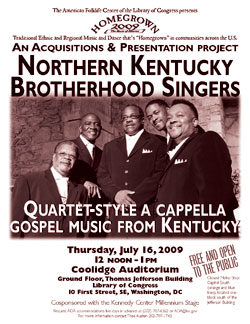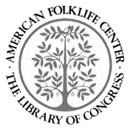| |
|||
|
The American Folklife Center at the Library of Congress presentsThe Homegrown 2009 Concert Series
|

|
The Northern Kentucky Brotherhood is a jubilee-style, a cappella, sacred gospel quartet from Covington, Kentucky. Nearly twenty-one years ago, Ric Jennings formed a five-voice "quartet (one lead and four harmony vocalists) out of the renowned Ninth Street Baptist Church Men's Choir. Since the beginning, this community-based quartet has sung in churches, at special gospel programs, anniversaries, song services, and other sacred music events, which in the words of folklorist Ray Allen "foster a communal atmosphere conducive to bringing on the experience of the Holy Spirit or as they say, 'shouting the church.'" In addition to continuing this traditional role of the gospel quartet, the Brotherhood reaches out to a global audience with both spiritual and secular songs. They have become an annual hit in Spain, Portugal, Italy, and Switzerland. They have also recently been discovered by many secular venues in the Cincinnati area, and by the National Folk Festival.
Influences
Many people who hear the Northern Kentucky Brotherhood are amazed at the blending of their harmonies and the driving force of their rhythm, especially when words are replaced with sounds and voices become instruments. The group has many influences, but probably the most important were their early experiences in the family, in church, in school, and on street corners. The late 1950s and early 1960s was a vital time for gospel music of all forms. Adult and youth choirs, as well as men's and women's choruses and quartets, were popular in Northern Kentucky and Cincinnati African American communities. At home, Ric Jennings heard recordings of popular quartets, including The Harptones, a local group he particularly admired. He remembers watching his father practice with the Ninth Street Baptist Church Men's Choir in the early 1950s:
Bringing that harmony together and seeing how they were supporting the lead singer just dug down inside of me and gave me an opportunity to open up spiritually to the sounds and to understand the message in their singing, and at the same time watch those guys really enjoy themselves.
Ric and his friends found the church and the segregated Lincoln Grant Elementary School safe and supportive environments to learn music. Teachers taught them not just how to sing a note but how to enhance the sound. When desegregation came, Ric's stressful move to the formerly white Holmes High School was easier because his favorite music teacher from Lincoln Grant transferred with him. Many agreed that the Holmes band and chorus got much better with the influx of African American students and teachers.
As you listen to the Northern Kentucky Brotherhood, you will hear elements of jazz, rock, and doo-wop singing. Ric says:
When times were difficult you could resort to something that was fun, that made you happy, that brought happiness in midst of the storm. We doo-wopped any opportunity we'd get to stand on the corner or walk down the street knocking out some songs. The favorite corner was Robin and Greenup Streets in Covington or down to what we called the "bottom of the Projects." Somebody would start off a song, and you try to find your way in it. How do I do that harmony? How do I hold on to that note I remember they taught me in school? Okay, let's add a little something to this, man, to bring it up, let's up-beat it a little bit, so we don't fall asleep while we're singing it.
Getting "the Right Flavor
A Northern Kentucky Brotherhood practice session resembles the street corner scene described above. A member brings in a recording, the group listens, and each member finds his part. After two listens, they have the basic song harmony. Then they work to memorize the words and "enhance the song," using elements from different genres of music. Ric talks about not trying to sound like someone else:
We just want to pull out some of that flavor, that flavor that feels so good to the taste buds of the souls. If you've got tight harmony there is still room for you to tuck something in or bring something out. Folks are looking at you like "How did you do that? How were you able to tickle me with whatever you tucked in the song?" Each voice applies its own flavor to a song. Songs correspond to our individual personalities. We can sing each other's songs but the flavor won't be the same.
Singing in the Brotherhood is analogous to fine cooking because each member brings his own personal flavor to a song, like the perfect blend of seasoning in an exquisite dish. Enhancing the song is like adding spices. You can see it in their faces and hear it in your ears when they get it right.
Watching their faces, body movements, and signals will also give you a glimpse of their creativity on stage and how they communicate. The Northern Kentucky Brotherhood is most at home in a church where the interaction of the congregation supports the group. The group, in turn, supports the spiritual communion of the church. They have an uncanny ability to adapt their songs to any audience, but what happens at a performance depends on the reaction and response of the audience. Therefore, the audience is one of the most essential ingredients in getting "the right flavor."
Bob Gates
Director, Kentucky Folklife Program
 The American Folklife Center was created by Congress in 1976 and placed at the Library of Congress to "preserve and present American Folklife" through programs of research, documentation, archival preservation, reference service, live performance, exhibition, public programs, and training. The Center includes the American Folklife Center Archive of folk culture, which was established in 1928 and is now one of the largest collections of ethnographic material from the United States and around the world. Please visit our web site.
The American Folklife Center was created by Congress in 1976 and placed at the Library of Congress to "preserve and present American Folklife" through programs of research, documentation, archival preservation, reference service, live performance, exhibition, public programs, and training. The Center includes the American Folklife Center Archive of folk culture, which was established in 1928 and is now one of the largest collections of ethnographic material from the United States and around the world. Please visit our web site.
| ||||
